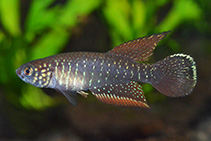| Family: |
Rivulidae (Rivulines), subfamily: Cynolebiinae |
| Max. size: |
7 cm SL (male/unsexed) |
| Environment: |
benthopelagic; freshwater |
| Distribution: |
South America: Laguna de Maricá and Laguna de Saquarema basins in Brazil. |
| Diagnosis: |
Dorsal spines (total): 0-0; Dorsal soft rays (total): 13-18; Anal spines: 0-0; Anal soft rays: 19-24; Vertebrae: 31-31. Having greenish golden vertical lines on body side and vertical golden lines on dorsal fin . Dorsal head profile slightly convex to nearly straight in male, gently concave to approximately straight in female (Ref. 42934). |
| Biology: |
Found in small freshwater temporary pools, 10-40 m of diameter, about 50 cm deep, in floodplains of streams and lagoons or along the vast floodplains of lower rio São João, which are sometimes close to the sea (about 100 m). Substrate of compact, soft reddish brown mud; water hyaline, yellow or dark orange brown, usually not turbid. These pools are dry twice a year, once during winter, usually from July to August, and again during summer, usually from February to March. During dry season, all fish die and eggs undergo in diapause within the substrate. Eclosion happens at the onset of wet season, usually March-April and September-October (Ref. 42934). |
| IUCN Red List Status: |
Critically Endangered (CR); Date assessed: 07 November 2018 (B2ab(i,ii,iii,iv)) Ref. (130435)
|
| Threat to humans: |
harmless |
Source and more info: www.fishbase.org. For personal, classroom, and other internal use only. Not for publication.
